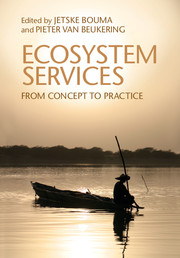Book contents
- Frontmatter
- Contents
- About the authors
- Part I Introduction
- Part II Measuring ecosystem services
- 2 The role of biodiversity in the provision of ecosystem services
- 3 A traits-based approach to quantifying ecosystem services
- 4 Mapping ecosystem services
- Part III Valuing ecosystem services
- Part IV Paying for ecosystem services
- Part V Governing ecosystem services
- Index
- Plate section
- References
2 - The role of biodiversity in the provision of ecosystem services
from Part II - Measuring ecosystem services
Published online by Cambridge University Press: 05 February 2015
- Frontmatter
- Contents
- About the authors
- Part I Introduction
- Part II Measuring ecosystem services
- 2 The role of biodiversity in the provision of ecosystem services
- 3 A traits-based approach to quantifying ecosystem services
- 4 Mapping ecosystem services
- Part III Valuing ecosystem services
- Part IV Paying for ecosystem services
- Part V Governing ecosystem services
- Index
- Plate section
- References
Summary
Introduction
All organisms respond to and change their environment to a greater or lesser degree. This interaction affects their survival and that of other organisms. Humankind is no different: it has responded to and altered its environment. For example, humans burn landscapes and domesticate plants and animals (Schleidt and Schalter, 2003; Archibald et al., 2012). However, unprecedented in the history of our earth is the extent of environmental changes brought about by this single species (Haberl et al., 2007; Rockström et al., 2009a; Klein Goldewijk et al., 2011). Our presence is identifiable everywhere on earth, thus, the current geological epoch has been dubbed the Anthropocene (Steffen et al., 2007) and humankind exploits all earth’s ecosystems, whether seemingly pristine like the vast ice fields of Antarctica and the high seas of the open ocean, or highly modified and regulated, like the terraced rice fields of Asia or dykes of the Netherlands.
Ecosystems provide us with a range of goods and perform services without which humans would go extinct. While some ecosystems have been optimized by humans to deliver and sustain a specific service, few services have been fully incorporated into a market economy whereas several are being depleted without societal appreciation (Fisher et al., 2008; Rockström et al., 2009a; Bateman et al., 2010). The notion of imminent depletion has led concerned scientists to draw up the MEA (MEA, 2005). The MEA analysed the present condition of the earth’s ecosystems as an integrated product of changes in biodiversity, environmental change, and their effect on ecosystem services. The assessment concluded that much of the gain in economic growth and human well-being over the last century has been possible because of large-scale exploitation of the services that natural ecosystems provide. The resulting degradation of ecosystems and loss of biodiversity is thought to diminish future use of ecosystem services and to endanger our planet’s sustainability. Rockström et al. (2009a) have framed this in the form of eight planetary boundary indicators that together depict a safe operating space for humankind (Figure 2.1). For many indicators the world is considered to be “close to the edge,” and among these biodiversity loss was judged to be the furthest outside the planetary boundary.
- Type
- Chapter
- Information
- Ecosystem ServicesFrom Concept to Practice, pp. 25 - 39Publisher: Cambridge University PressPrint publication year: 2015
References
- 1
- Cited by



